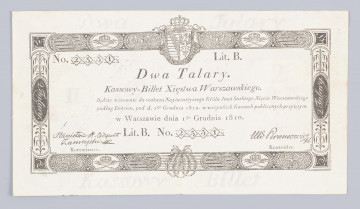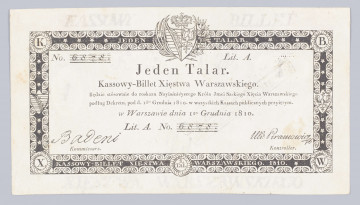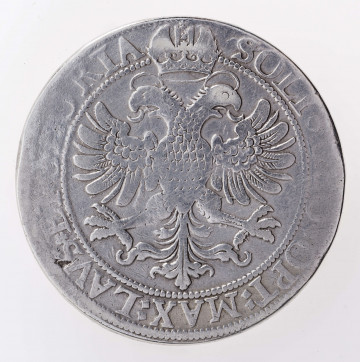
Treasury Ticket of the Duchy of Warsaw - 2 thalers
1810
National Museum in Lublin
Part of the collection: Paper money of the Kościuszko Uprising and the Duchy of Warsaw
From the very beginning, the idea of reintroducing paper money faced a problem of public distrust. It was the result of bad experiences with paper money from the time of the Kościuszko Uprising and the actions of the Austrian authorities, who introduced the so-called ‘bankocetl’ circulating also in the Duchy of Warsaw after 1809. A disadvantage of both currencies was their lower market value in relation to the nominal one. Lack of trust in paper currency resulted not only from past experiences, but also from mistakes made when introducing tickets into circulation. This was mainly the restriction that only 50 per cent of taxes could be paid with cash tickets. In addition, although the exchange of tickets for bullion money was guaranteed, the Main Exchange Office charged a fee of 4 groszy for each paper thaler. Also, the assurance that the money issued was to be secured by ‘all customs revenues’ of the Duchy of Warsaw was not encouraging. The people of the Duchy were aware of the illusory nature of this security. They were only too well-aware of the extremely difficult economic situation of the state. As a result, tickets were accepted very reluctantly, and for all practical purposes they lost their purchasing power after Napoleon's retreat from Moscow.Significantly, when Field Marshal Kutuzov issued a decree in January 1813 setting the exchange rate for all types of money used in the Duchy after the Russian invasion, it completely ignored cash tickets. Initially, it was planned to collect them from the market by means of redemption, which is confirmed by quite frequent copies bearing on the back the stamps of the Central Liquidation Commission, which was to take care of this task. Ultimately, the tickets were not redeemed.
Nowadays, the rarest denomination is the five-inch tickets. This is mainly because they were issued in the smallest number – 60,000 copies. It is interesting that five-inch tickets were the only ones with figural images: Mercury as a symbol of trade, and a woman – probably a personification of freedom. They were also distinguished by the omission of the initials X. and W., which were abbreviations of the words 'Duchy of Warsaw', in the lower corners of the decorative frame.
Leszek Poniewozik
Author / creator
Dimensions
cały obiekt: height: 96 mm, width: 174 mm
Object type
paper money
Technique
typography
Material
paper
Creation time / dating
Creation / finding place
Owner
The National Museum in Lublin
Identification number
Location / status

1810
National Museum in Lublin

1810
National Museum in Lublin

1621
National Museum in Lublin
DISCOVER this TOPIC
National Museum in Szczecin
DISCOVER this PATH
Educational path